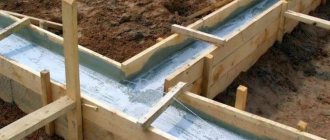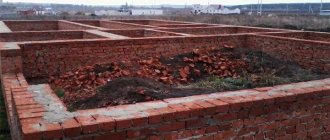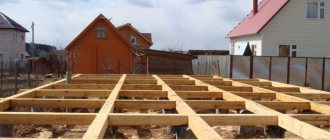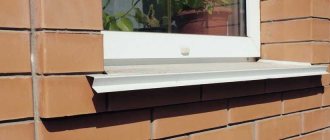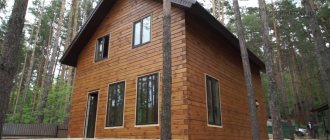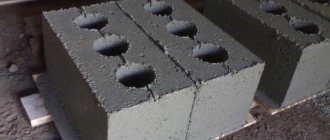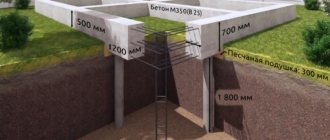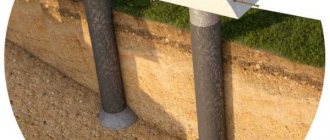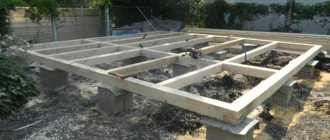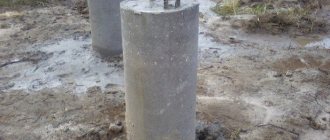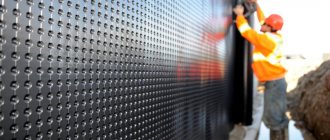There are often situations where construction conditions do not satisfy at least the minimum requirements of the standards.
Most often this is due to unsuitable soil conditions.
Excessive plasticity or fluidity, waterlogged or excessively loose soils, peat bogs and other problem areas force us to abandon generally accepted and traditional support structures.
In such cases, a pile foundation is used, which depends little on the quality of the upper layers of the soil, since it rests on deep dense rocks.
Considering the abundance of problem regions, the technologies for constructing pile foundations have been developed for a long time and allow some types to be installed independently.
What is a pile foundation
A pile foundation is a system of point supports immersed in the ground to a certain depth before contacting solid layers.
The length of the vertical elements can be significant , depending on the depth of stable soils and often exceeds the height of the above-ground part of the building.
The upper part of the supports is rigidly connected into a single system, which allows you to distribute the load across all piles and obtain the most efficient mode of operation of the base. The strapping is called a grillage; it is designed to receive and transmit loads to the support rods .
According to the principle of operation, the operation of a grillage is in many ways similar to the functions of a strip base, but the difference between them is that the strip rests on the prepared soil surface along its entire length, and the strapping is installed on the top points of the piles.
This difference puts forward special requirements for the rigidity and strength of the grillage beams, the spans of which work only due to the own rigidity and strength of the walls.
Pros and cons of a screw foundation
Using screw piles when constructing the foundation of a building has many advantages. The main advantages of this design:
- This type of foundation is much stronger than reinforced concrete structures.
- The price of a screw foundation is much lower than many other types of foundation. Thus, the savings can be distributed to other types of work.
- Screw foundation piles are installed quite quickly. Their installation takes only 2-3 days, which cannot be compared with the hardening time of concrete foundations.
- Loose soil will not budge a deeply driven pile, making installation easier in a variety of soils.
- Excellent for construction in hilly areas. Piles are also indispensable when constructing houses on slopes.
Installation of piles is considered quite simple for these and some other reasons. For example, when constructing such a foundation yourself, 2-3 people are enough to drive the piles. Digging ditches or holes is not required, and there is no need to use equipment.
But, in addition to the advantages, the pile foundation also has its disadvantages. The most serious drawback is the corrosion that piles are susceptible to.
In addition, there are some areas where the use of piles is not possible. And you can’t screw them in near an already built building, as the walls will get in the way.
There are also restrictions on the parameters of the building under construction due to its dimensions. This is due to the low load-bearing capacity of the structure. But it is still worth remembering that the cost of a screw foundation is low and corresponds to the quality.
Kinds
There are various design options for a pile foundation, each with its own specific characteristics.
According to the material of the supports there are:
- Wooden . Sanded logs with a pointed end are used. The most ancient type of piles, which has practically disappeared at present. The reasons for this were the disadvantages of wood as a building material and the availability of stronger and more durable options. Occasionally found in private construction as supports for auxiliary or outbuildings.
- Metal . There are two types of metal piles - screw and driven. Screw piles resemble screws that are driven into the ground using cutting spiral blades on a pointed tip. Driven piles are not specially produced and are pieces of various types of rolled metal - channel, I-beam, rail, etc. They have high strength and are able to bend plastically while maintaining load-bearing capabilities. The disadvantage is the tendency to corrosion, which reduces the service life of the supports.
- Reinforced concrete . There are two types of reinforced concrete piles - driven and cast-in-place. The first ones are produced in specialized production conditions, have a robust design with stressed longitudinal reinforcement and are resistant to all loads. The latter are made directly on the site by filling the formwork (waterproof pipes) placed in the well with dense grades of concrete.
By load transfer method:
- Rack piles . They are supports that are in rigid contact with dense layers of soil. The depth of the shafts depends on the level of hard rocks.
- Hanging piles . They do not have support in the lower part of the trunk, using only friction on the side walls and partial support on the ground. There are both driven and cast-in-place friction piles. The load-bearing capacity depends only on the depth of immersion; for stuffed ones, it is enhanced by thickening in the lower part of the well.
By design:
- Hammers . They are a monolithic rod with a pointed end, immersed using mechanical action at the upper end.
- Printed . They are a concrete casting into a pre-prepared well. They have a lower load-bearing capacity than driven piles, but can be made independently.
- Screw . They are made from a pipe with a pointed tip and spiral blades. They can be installed independently, although in practice this is only used for auxiliary buildings or structures.
IMPORTANT!
All types of piles, regardless of design or material, are capable of working effectively on complex or problematic soils.
Construction of houses
585 votes
+
Vote for!
—
Vote against!
In fact, not a single building can be built without creating a foundation for it, that is, a foundation. As is known, there is a wide variety of types in the construction industry. This article will discuss the features of a pile foundation. Let's look at the main stages of installing this type of foundation with our own hands and study its design.
Table of contents:
- What is a pile foundation, design features
- When and why to choose a pile foundation
- Stages of installing a pile foundation
- Well drilling, concreting and reinforcement. Grillage arrangement
- Basic location and materials of piles
- Limitations on the use of pile foundations
- Necessary materials and tools for installing a pile foundation
What is a pile foundation, design features
A pile foundation is a foundation made of rigid piles immersed in the ground, which are placed along the perimeter of the structure of the future building. These same piles come in various types, they are classified according to many criteria:
- according to the method of deepening the support;
- by the method of impact on the soil;
- by material;
- by section type, etc.
It is worth clarifying that this type of foundation is most often used during construction in difficult areas where heaving soil prevails. The pile itself is a rod, the upper part of which is called the head, and the lower part is called the sole. The sole itself can be widened or pointed; it can also be purchased either ready-made or made independently at the workplace. The table shows the main types of piles, according to the method of deepening the support.
| Classification of piles according to the method of immersion in the ground | |
| Hammered look | To place the support in the ground, special vibratory hammers, etc. are used. |
| Printed look | The principle of operation is to drill wells and use concrete pouring. |
| Drilling view | Ready-made structures are installed in drilled wells. |
| Screw view | Piles are installed manually due to their drill-like shape. |
Regarding the method of impact on the ground, hanging and pile-racks are distinguished. The first type involves the distribution of loads that appear as a result of friction of the earth against the sides of the support. The second transfers the load to a durable layer of earth; it is not characterized by settlement.
As for the division of piles into types relative to material, here we distinguish:
- reinforced concrete;
- wooden;
- steel piles.
Reinforced concrete supports are durable, steel supports are expensive, and wooden ones are cheap.
Pile foundations come in the following types: field, strip, single and cluster. Single piles are distinguished by the simplicity of the installation process; they are used as supports when constructing a porch, etc. For the construction of frame structures, the strip type is used; it is economical and reliable. Cluster piles are used on large, large-scale construction sites with increased load on the land area. Field piles are usually placed at even intervals. Multi-storey buildings are being erected on them. The choice of one type or another depends on the climatic characteristics of the territory, the topography of the land plot, and the technical characteristics of the planned building.
A number of advantages of using a pile foundation with a grillage include:
- minimizing financial costs for construction;
- reduced construction time for the foundation of the building;
- make it possible to avoid wet work when installing cast-in-place and screw piles;
- the ability to carry out construction work at any time of the year;
- minimal harm to the environment;
- installation work regarding the grillage does not cause harm to nearby buildings;
- on properly selected soil, the service life of such a foundation is more than 100 years;
- Pile foundation designs are famous for their reliability and durability.
When and why to choose a pile foundation
As a rule, pile foundations are chosen for the construction of low-rise, civil, industrial, and small-sized buildings. This type of foundation is considered an excellent option when creating country cottages and dachas. Pile foundations are implemented on such types of soil as:
- plant soils;
- quicksand;
- loess-like;
- clay soils, etc.
In areas with high density soil, choosing a pile foundation can significantly reduce labor-intensive excavation work. This type of foundation does not require heavy digging of a pit.
Another reason for using a pile foundation is the high level of groundwater. It is suitable for soil that is prone to deep freezing in winter, but a pile foundation is not capable of conquering rocks.
Stages of installing a pile foundation
The creation of a pile foundation can be described based on several stages and it is worth noting that it does not require lengthy preparation before starting work. So,
Stage 1. Digging holes for piles. They are usually placed along the entire perimeter of the construction site, while the diameter of the dug pits depends on the future dimensions of the structure.
Stage 2. Installation of roofing felt pipes. At this point, it is worth considering that the length of this type of pipe should be 3 meters the length of the very depth of the pit, since the formwork of the building structure is created on the basis of the upper parts of the piles. Installations without the use of roofing felt pipes have a lot of problems and inaccuracies, they are prone to rapid destruction.
Stage 3. Concreting and reinforcing piles. First, the reinforcement process takes place, which consists of using reinforcing bars to connect the supports to the grillage. After this, you can begin concreting, which, by the way, also depends on the use of roofing material, since their absence leads to the diffusion of cement laitance. The process of concreting piles involves pouring the solution in portions so that the concrete layer does not exceed 5 meters.
The most common foundation options for building small country and private houses are foundations on screw and self-leveling piles.
Creating the first option requires the presence of tools such as a welding machine, a construction (water) level, a tape measure, etc. The entire process of installing a foundation on screw piles can be displayed step by step.
1. Marking the area. For this purpose, it is better to use a hole to mark the territory; the use of pegs and cord in this case is not a rational option. It is worth considering that these loots should not be deep, otherwise it will disrupt the entire technological process.
2. Next, you can start drilling screw piles. It is better to carry out this process together rather than alone, since at this stage you need to check each screwed support with a level.
3. When all the supports are installed, they are concreted and the grillage is installed.
As for the foundation on self-leveling piles, the process of its installation is considered more expensive, financially and materially, as well as complex. But be that as it may, practice shows that it is quite possible to build it. For this:
- use a cord and pegs to mark the construction area;
- using a hand drill, pits for piles are created in the indicated places. Their depth must be at least 1.5 meters.
- the piles are treated with waterproofing material (roofing felt), it is better to do this in two layers, for reliability. Ruberoid protects concrete supports from moisture provided by nearby groundwater.
- all piles are connected by a reinforcement cage.
- After reinforcement, the pits with piles are filled with concrete. At this stage, you will need a special vibrating technique that allows you to compact the solution.
- You can start grilling the foundation only after the concrete layer has completely dried.
Well drilling, concreting and reinforcement. Grillage arrangement
After marking the area allocated for the construction of the foundation, you can begin drilling pits for piles, the number of which depends on the expected weight of the future building. The diameter of a hand drill for this purpose is no more than 30 cm, and they can be purchased at almost any industrial store. Such designs allow you to make a pit up to 5 meters deep. In cases where it is planned to create a large-sized building and the installation of large-sized supports is required, then motorized and electric drills are used, the diameter of which is 50-60 cm. In difficult areas, the help of drilling machines is used.
In construction, grillages are divided into two types: prefabricated, which is a structure made of iron sticks, and monolithic. For both, there are significant rules that should not be ignored:
1. The height of the grillage must be more than 3 meters.
2. The width should be less than 4 meters.
Prefabricated devices are typically fastened to the top of the supports; for this, at the concreting stage, the piles are supplemented with T-shaped rods. A reinforced rod is additionally fixed to the pile head in a horizontal position.
The formation of a monolithic grillage takes place in several steps.
1. Installation work to create formwork.
2. Reinforcement of piles.
3. Filling the grillage tape.
It is worth pointing out that the main task of the grillage is to evenly distribute the load on the foundation. The classification of the grillage relative to the level of penetration into the soil is considered no less significant. There are high, elevated and in-depth levels. The first is located above the ground, the second is installed at ground level, and the third is completely in the soil.
Basic location and materials of piles
Most often in construction there are metal and reinforced concrete piles. In the first type of production, metal beams of various diameters are used, which depends on the dimensions of the foundation. In addition to beams, steel profiles and pipes are used. Metal structures have one of the main advantages - strength. Before immersion in the ground, this type of piles should be thoroughly treated with anti-corrosion solutions. Piles from are widely used for:
- construction of various fences, fences;
- arrangement of non-permanent foundations of non-stationary structures such as, for example, shopping pavilions.
- construction of the foundation of small-sized, lightweight structures made of foam concrete, panel panels, etc.
Reinforced concrete piles are resistant to any type of soil. The structures are suitable for the construction of houses with more than 5 floors, as they are considered quite resistant to heavy weight and loads. This group of piles is actively used for:
- creating a foundation for hydraulic structures;
- laying the foundation of road and railway bridges.
- when constructing engineering structures such as power lines.
- arrangement of hangars, etc.
Limitations on the use of pile foundations
Along with a wide range of applications, due to its price and advantages, the pile foundation also has limitations in use. This type of base is not suitable for:
- Horizontally mobile type of soil that is not resistant to overturning. Therefore, at each construction site, before starting work, it is recommended that the soil be sent to a laboratory for geological examination.
- A pile foundation has difficulties with the construction of a plinth, in which cracks form between the piles; in order to neutralize them (create a back-up), large financial investments will be required.
Necessary materials and tools for installing a pile foundation
When installing a pile foundation, you will need the following tools:
- Boer;
- scrap;
- shovel;
- metal rods;
- roulette;
- building level;
- welding machine;
- cord, etc.
The required materials include crushed stone, cement for mortar, sand, etc.
The most important tool in the production of a pile foundation is, of course, considered to be a drill, with the help of which the number of wells required for the construction site is prepared for the piles. Drills come in different designs and types, but most often, a hand drill is used to create such a foundation. Such a tool does not require special skills and technology to use and has an affordable market price. Some amateur craftsmen assemble the drill at home. Correctly selected tools will allow you to make pits of the required depth without unnecessary physical effort, while maintaining their qualities of strength and heat resistance.
For more information on the topic, watch the video:
Device
The main part of the work on creating a pile foundation comes down to immersing the trunks in the ground.
This is the most difficult and critical stage, which determines the strength and stability of the entire system.
If failure, failure, or other problems occur during immersion, the ability of the entire base to perform its function is compromised. Any deviations during the work indicate non-compliance with the technology, unscrupulous geological survey of the site or low quality of piles .
The second stage is the creation of a grillage. It performs equally important functions and must meet all existing requirements.
The technology of creation directly depends on the type of piles, material of manufacture and parameters of the future house .
For light buildings, the grillage can be made of wood (a beam or a bundle assembled from an edged board until the desired thickness is obtained).
When using metal piles, it is customary to create a grillage from metal - a channel, an I-beam or a profiled pipe.
For reinforced concrete piles, the grillage is cast from concrete using a technology reminiscent of making a strip foundation.
NOTE!
Both stages of creating a pile foundation must be carried out by experienced builders or, at a minimum, under the supervision of a competent specialist. There may be violations of the technology or deviations from the calculated parameters , which must be noticed and corrected in a timely manner, which is not always possible for untrained people.
Description of screw piles.
The main element of the foundation is a metal screw pile. It is a regular steel pipe. In this case, the thickness of the metal must be at least 4 mm.
At the sharp end of the screw pile there is a cutting blade. Thanks to it, screwing into the ground occurs. Due to the ideal shape of the blades, they can simply be screwed in to the desired depth using the strength of 3-4 builders.
For objects that have differences in height or other lateral loads, piles are used with two blades at the sharp end. This gives additional reliability to almost any structure.
The diameter of the blades ranges from 200–850 mm. In appearance, the pile resembles a huge self-tapping screw. It has a diameter from 50 to 350 mm. Its length is 2–11 m. The smallest piles are used to install fences, billboards, and canopies. Hollow and solid piles are available on sale.
Installation of screw piles, video:
Thanks to the perpendicular arrangement of the blades, the propeller does not loosen the soil. The bearing capacity of these piles ranges from 5-25 tons. There are different options for foundation designs. They depend on the type of future structure and soil. The most popular of them:
- single piles (support individual elements) are often used when it is necessary to attach something to an existing building;
- standard foundation - used for columns and main elements of the structure;
- pile strips – located under the walls of the building;
- pile field - used for heavy structures.
For a wooden house, choose strong and durable piles with cast tips.
Particular attention must be paid to the protective coating of this building material. To check its quality, you can ask the seller to do a test twist.
If the metal is very exposed, then the screw piles are covered with poor protection.
The best coating is made from high quality polyurethane resin. Galvanized piles are no less reliable. They are processed using hot galvanizing. They are covered with protection both outside and inside.
9e3f2daea4a671ec158783c323f57b9c.jpe
Advantages of these piles:
- Possibility of their reuse. This is due to the fact that they are dismantled without any damage.
- There is no need to carry out a large amount of excavation work. The construction of a pile-screw foundation is possible in flooded and moving areas.
- Installation of this foundation is carried out in 1–3 days. Work done manually takes longer than work done using special equipment.
- Construction of the house begins immediately after installation of the head.
- They are ideal for constructing various extensions to a building.
- The service life of a pile-screw foundation is 150 years. After additional treatment, screw piles can last more than 200 years without replacement.
- The cost of constructing this foundation is almost three times lower than that of a strip foundation.
- After the construction of the foundation, no construction waste accumulates on the site.
The disadvantages of screw piles are few:
- they cannot be used on coarse and rocky soils;
- soil subsidence due to poor site inspection;
- deformation of the foundation that occurs when the technology is violated (this is possible if, when screwing in the piles, their position was not fixed, they were installed in pre-dug holes or driven in, or the piles were tied incorrectly);
- corrosion of piles due to lack or poor anti-corrosion treatment;
- limiting construction to light and small houses, for example, from wood concrete or polystyrene concrete.
How to calculate diving depth
The depth of immersion of piles is determined based on their type:
- Rack piles are immersed to the depth of dense layers of soil. In this case, no calculation will help; it is necessary to drill test wells and determine the true level of solid soils.
- Friction piles have a load-bearing capacity that is determined by the properties of the soil and the length of the side surfaces. The higher the load, the longer and, accordingly, deeper the pile must be immersed .
- Bored piles rest primarily on a wide platform - a cushion. Its area is determined by the soil resistance and the magnitude of the vertical load.
- For screw piles, the immersion depth is determined by the level of soil freezing in winter. This parameter is relevant for all types of piles , but other types usually sink much lower.
A complete engineering calculation of immersion depths is a complex and responsible task, which not all specialists risk taking on.
Therefore, independent calculation is strongly not recommended; you should contact a specialized design organization.
At a minimum, you can use an online calculator.
Selection of building materials
Currently, foundation piles can be purchased either assembled or disassembled. The price for ready-made screw piles for foundations is slightly higher than for prefabricated ones.
When choosing any of the two options, the most important point is that the seller provides the necessary product quality certificate. In such a responsible matter, the first thing is always safety.
Standard piles for screw foundations are fixed at 2.5 meters in length. Of this size, only 1 meter is left on the surface of the earth. Situations arise when this length is not enough. In this case, you can purchase longer piles.
Remember that piles may be required in different lengths. This option is possible in unstable soil. In addition, piles of different lengths may be needed when building a foundation on an uneven surface.
Calculating height above ground
The height of the pile foundation above ground level is determined by the height of the top line of the grillage.
Selecting the correct value is determined by several factors:
- Snow cover thickness in winter.
- Possibility of flooding, water level during spring floods.
- Groundwater level.
- Temperature conditions in the region.
By comparing these parameters, we come to the choice of the optimal height of the grillage.
The optimal values are considered to be 30-40 cm for conventional bases and 1.5-1.7 m in the presence of a basement.
IMPORTANT!
The possibility of equipping a basement room is extremely rare; most often, a technical underground is installed in which communications are located.
Step-by-step DIY installation instructions
Let's consider the procedure for creating a pile-screw foundation.
The work is carried out in stages, the sequence of actions has a strictly defined sequence:
Preparation
A pile-screw foundation has an important feature - it can be created on uneven terrain that does not require preliminary leveling (planning).
It is possible to build on slopes or in folds, which makes it possible to effectively use areas that are inconvenient from the point of view of traditional construction . Therefore, preparatory work can be reduced to clearing the area of plants and foreign interfering objects.
Make markings and mark all pile installation points with pegs. Then, small (up to 30 cm) recesses are made at the installation sites, which facilitate the entry of the blades into the ground.
The fertile layer of soil creates noticeable resistance due to the abundance of roots, plant stems and other obstacles, so it is better to remove it.
Driving piles
Installation of screw piles is done either manually or mechanically. Manual installation is possible in the presence of relatively soft soil without man-made inclusions or rock debris .
The diameter of the barrels available for manual immersion is limited to 87 mm.
The most common piles with a diameter of 108 mm are often too difficult due to the high soil resistance.
The machine method allows you to obtain high-quality installation of screw piles, observing a certain angle, screwing force and depth.
The power of construction equipment allows you to freely work with piles up to 159 mm in diameter, which is quite enough for the construction of a fairly large private house .
The piles are driven to a predetermined depth. Usually it is determined by the level of occurrence of dense layers, or the soil resistance force exceeds the force permissible for a given shaft, which breaks off the technological hole.
A pile that has reached the required level of adhesion to the ground rotates with great force or stops doing so altogether..
You cannot try to continue rotating - the welding may not hold up, the blades will come off and the pile will become unable to perform its functions.
NOTE!
When installing screw piles, it is forbidden to reverse - try to unscrew the trunk back. This weakens the adhesion of the blades to the ground and eliminates the possibility of repeated immersion in this place .
Harness
After installation of all piles, trimming is performed . This is a procedure that allows you to adjust the height of trunks protruding from the ground to a single level and form them into an even horizontal plane.
Install a laser level with the function of constructing planes at the required height and cut off excess sections of pipes.
After trimming, the internal cavities of the piles are filled with concrete, increasing their strength.
Then they install the strapping (grillage) - a belt that connects all the piles into a single system and at the same time serves as a supporting element for the walls of the house. The cut tops are covered with caps with horizontal platforms on which metal or wooden beams are installed.
For fixing on the platforms there are technological holes for bolted connections.
IMPORTANT!
Sometimes the trim and grillage are different elements. The piping is performed below the level of installation of the grillage and connects all the piles together, forming a system like a lattice. Metal sections of a channel or I-beam are used, welded to the walls of the trunks .
Main works
Arrangement of leader holes
Before starting the main work, it is necessary to prepare seats for screw piles, which are called leader holes. For these purposes, at the points marked with pegs, the top layer of soil along with the grass should be removed to a depth of about 10-15 cm.
The width of the prepared holes should exceed the diametrical size of the blade of the piles used by about 2-3 cm. In principle, you can do without such preparation; however, in this case, additional effort will be required to screw the supports into the ground during manual operations.
Please pay attention to the following preparation details:
When using special screwing mechanisms during work, there is, as a rule, no need to arrange leader holes.
It is not allowed to deliberately dig pits for screw supports and simply install their tip into the ground (even to a small depth).
The last requirement is explained by the fact that one of the conditions for high-quality installation of screw piles is the intactness of the surrounding layers of load-bearing soil, which allows you to effectively distribute the loads from the house.
Preparation and installation of piles
In order to reduce the cost of purchased building materials, full-fledged screw piles can be manufactured independently.
To implement this solution, you will need to stock up on pipes of the appropriate diameter, the choice of which depends on the calculated load on the pile-strip foundation of the house.
Such homemade piles are made from pipes of sufficient thickness, the surface of which must first be thoroughly cleaned of rust and then coated with a special protective compound.
Video: Homemade screw piles
After this, homemade blades from metal plates of the required size and shape are welded onto a part of the pipe blanks, pointed at one end, that is screwed into the ground.
To simplify the work with a homemade pile, two holes are drilled in its upper part in the walls, into which, when screwed in, a special lever in the form of a powerful rod is placed. Before installing the strip grillage, this part of the screw support is cut off using a regular grinder.
The installation procedure for finished metal supports is as follows:
Before screwing in, the tip of the pile is placed in a previously prepared hole, after which, using a special lever, its screw part is screwed into the ground.
Video: Installation of a pile-screw foundation
After all the piles are installed in their places, their upper cuts are leveled using a level, and the protruding parts are simply cut off with a grinder.
Then liquid concrete is poured into the pipe cavities, which increases the strength of the load-bearing base and provides additional anti-corrosion protection for the metal.
At the top of each of the homemade supports, rectangular metal plates are welded, which are subsequently used to connect to the grillage.
When screwing in the next support, you should constantly monitor the vertical line of its position.
Scheme for creating a bored base
Construction of a bored foundation is a more labor-intensive task.
Procedure:
Site marking
Excess vegetation or objects are removed. The surface of the site is planned, and if necessary, the top layer of soil is removed .
Then, using pegs, the points for creating bored piles are marked.
It is necessary to monitor the accuracy of compliance with the design data, carefully measure all distances.
Be sure to check the diagonals and make sure they are equal. If any discrepancies are found, errors are corrected immediately.
Drilling of the wells
Based on the marking results, wells are drilled . The depth is determined in the project; only the creation of depressions in the ground is required.
Sometimes a hand drill is used, more often special equipment is used, which significantly speeds up the work and improves quality.
If you need deep wells - from 3 m or more, manual methods cannot be used.
Reinforcement
Formwork is lowered into the finished well, the role of which is played by a piece of plastic pipe of the required length and diameter..
They often make do with a pipe rolled from roofing felt. It remains in the well and performs waterproofing functions.
Then the reinforcement frame is assembled . Usually it is a spatial lattice of 4 vertical working rods connected by transverse sections of thin smooth reinforcement.
The dimensions of the frame should allow it to be lowered freely into the well, but not allow it to dangle too freely in it.
The optimal distance of vertical rods to the walls of the well is 3-5 cm.
Pouring concrete
Heavy grades of concrete from M200 and above are used for pouring . Either ready-made material is used, or one made independently right there on the spot.
The entire cavity of the well is filled with concrete and bayonet is performed - a long rod is used to pierce the concrete, removing air bubbles from it.
After pouring, the concrete should be cured to gain structural strength. This period lasts from 20 to 30 days depending on the diameter of the wells .
Harness
The piping of drilled wells involves the creation of a grillage - reinforced concrete tape.
Its dimensions are close to the parameters of a shallow strip base, therefore the entire method of manufacturing a concrete grillage is as close as possible to the tape casting technology.
The only difference between them is the lack of support on the ground, which forces the construction of formwork in the form of a trench with a durable bottom.
The result is a powerful and durable concrete belt located under all load-bearing walls and connecting bored piles into a single support system.
Facing the foundation on screw piles
When the foundation is ready, you need to line it, because in its original form the screw foundation does not have an aesthetic appearance. By choosing the type of cladding, you can not only improve the appearance of the foundation, but also give it additional strength. This is already the stage of work that can be done independently, without the help of specialists.
But let's turn to the experience of builders. Despite the fact that the finished foundation already has excellent supporting and protective qualities, it doesn’t hurt to strengthen them. Moreover, weather anomalies, as well as ground disturbances beyond those calculated, have not been canceled. Screw piles are designed for a wooden house, so the foundation should look harmonious and further strengthen the foundation. Artificial or natural stone is perfect for this role, which is what we use for finishing.
Finishing from these materials is intended not only to create aesthetics in the overall ensemble, but also to give the structure additional strength. Separately, we note that the stone foundation will also protect the tree from snow and water
If there is heavy rainfall in your region, pay attention to such a property of the finishing material as hydroponicity
The cladding serves not only the role of decoration. As experts note, the stone also performs additional reinforcing functions. If stone is used for cladding, there is no need to perform additional reinforcement of the screw foundation; the cladding can perform this function.
Pay attention to the solution. It is part of a fortification structure
It would be good to add plasticizers to it so that the solution acquires plastic properties
This is important, because the foundation on piles, due to its design, is dynamic and can move during seasonal soil disturbances. To ensure that the cladding strengthens the structure and does not provide unnecessary resistance, give it plasticity using a solution with plasticizers
After choosing the cladding material, the question arises about the height of the finish. Here the opinions of experts differ. Some recommend laying only the foundation, others recommend finishing up to the window openings. The truth is, as always, in the middle. The finishing height depends on the specific weather conditions of the region - the greater the temperature difference, precipitation, soil fluctuations, the higher the finishing (reinforcement) should be completed.
The stone is fastened using a special solution based on concrete and plasticizers. The mixture is prepared immediately before starting work. Each element is thoroughly lubricated with the solution and laid out on the surface. After finishing work is completed, all seams should be thoroughly coated with a fixing solution. After drying, they can be painted with regular paint.
Grillage technology
Installation of a grillage is the process of creating a load-bearing belt for walls.
Procedure:
- Construction of formwork. A durable gutter is installed from board panels, the internal dimensions of which repeat the cross-sectional shape of the grillage.
- The inner surface of the formwork is hermetically covered with a layer of polyethylene or roofing felt. This is necessary to prevent concrete leaks during pouring.
- The reinforcement cage is assembled and placed inside the formwork. It is welded to the armored well belt , forming a single frame for all elements.
- Concrete is being poured. The process must be completed in one go, breaks are not allowed. Pouring is carried out from different points, evenly distributing concrete along the entire length of the formwork.
- After pouring, the tape is covered with burlap or polyethylene and kept for 28 days. The formwork can be removed after 10 days .
- The finished grillage is carefully waterproofed and proceeds to further construction.
